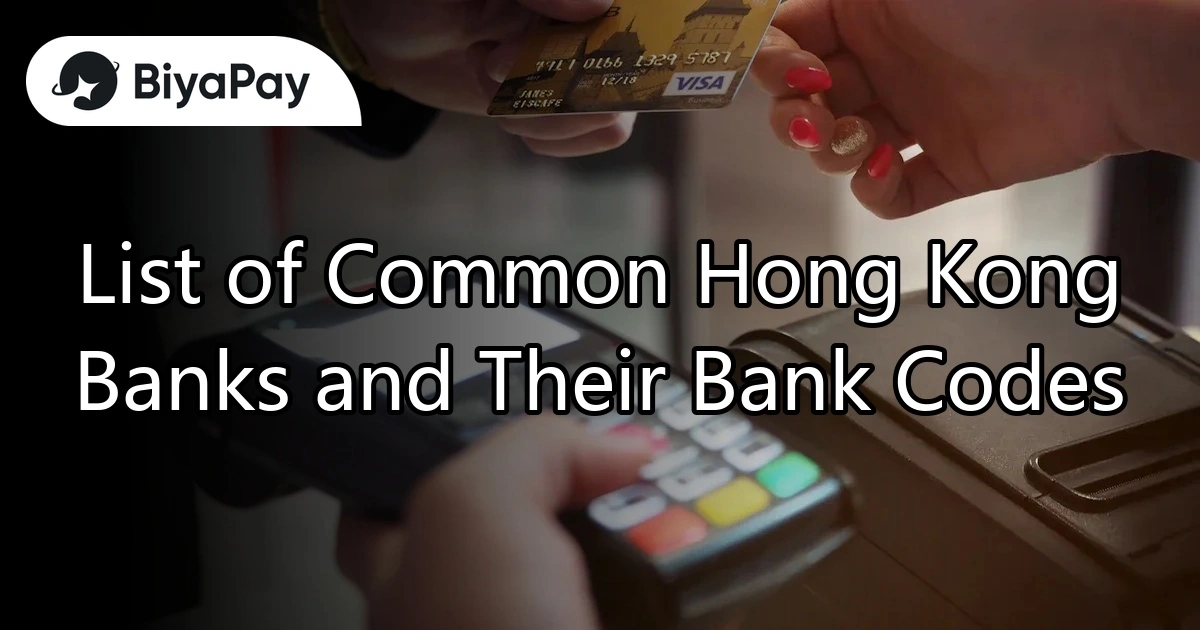- EasyCard
- Trade
- Help
- Announcement
- Academy
- SWIFT Code
- Iban Number
- Referral
- Customer Service
- Blog
- Creator
List of Common Hong Kong Banks and Their Bank Codes

Image Source: unsplash
When you make transfers or payments in Hong Kong, the bank code is very important. The bank code is a set of three digits that helps you identify different banks. The table below lists common Hong Kong banks and their bank codes, including Citibank’s bank code. This information can help you quickly find the correct bank when operating through online banking or ATMs.
| Bank Name | Bank Code |
|---|---|
| HSBC | 004 |
| Standard Chartered Bank | 003 |
| Citibank | 006 |
| JPMorgan Chase Bank | 007 |
| China Construction Bank (Asia) | 009 |
| Bank of China (Hong Kong) | 012/014/019 |
Key Points
- The bank code is a mandatory three-digit number for Hong Kong bank transfers, accurately identifying different banks to ensure funds safely reach the correct account.
- Citibank’s bank code is 006, and the correct code must be entered during transfers or payments to avoid misdirected funds.
- Both bank code and branch code need to be filled in; incorrect entries may lead to funds being returned and additional fees.
- You can check the latest bank and branch codes through official websites, bank apps, or customer service hotlines to maintain accurate information and avoid errors.
- Bank codes are only used for local transfers; international remittances require SWIFT codes, and the two must not be confused.
Bank Code List

Image Source: pexels
Major Banks List
When handling bank transfers in Hong Kong, the bank code is a required piece of information. The bank code is a set of three digits, with each bank having a unique code. These codes help you distinguish between different banks, ensuring funds reach the recipient’s account correctly.
Some banks may have more than one bank code. For example, Bank of China (Hong Kong) has three bank codes: 012, 014, and 019. This is because Bank of China (Hong Kong) is assigned different codes under different clearing systems or services. When filling in transfer details, you should enter the correct bank code provided by the recipient to avoid transferring funds to the wrong bank.
Tip: When entering the bank code in online banking or at an ATM, carefully verify the bank name and code, especially when a bank has multiple codes.
Citibank Bank Code
The Citibank bank code is essential information you need to know when using Citibank services in Hong Kong. When you need to transfer funds from other Hong Kong banks to a Citibank account or set up automatic transfers or payments, you must enter the correct Citibank bank code. Citibank’s bank code is 006. By entering this code in transfer forms or online banking, you can ensure funds reach the Citibank account correctly.
You may notice that the bank code format is the same for all banks, consisting of three digits. Citibank’s bank code is universally recognized in Hong Kong’s banking system. No matter which Hong Kong bank you use for the transfer, as long as the recipient’s account is with Citibank, you need to enter Citibank’s bank code 006.
Sometimes, when setting up automatic transfers or payment services, the banking system will require you to enter the recipient bank’s bank code. In such cases, Citibank’s bank code is crucial. By entering 006, the banking system will automatically recognize the recipient bank as Citibank.
Note: Citibank’s bank code is only applicable for local bank transfers in Hong Kong. If you need to make international remittances, you must also check Citibank’s SWIFT code.
When managing daily finances, making payments, or transferring funds, remember to verify Citibank’s bank code. This reduces errors and ensures every fund reaches the correct account safely.
Bank Code Definition

Image Source: pexels
Purpose
The bank code is a set of three digits, which you can also call a bank code, clearing code, or classification code. This code helps you identify each Hong Kong bank. For example, HSBC’s bank code is 004, and Hang Seng Bank’s is 024. Bank codes are used during transfers, payments, or automatic transfers. When used together with the branch code, the bank code ensures funds are accurately deposited into the designated account. If you enter the wrong bank code, funds may be returned, transactions may be delayed, or additional fees may be incurred.
Bank codes are vital in Hong Kong’s financial system. You need them for daily transfers, automatic transfers, and cross-border payments. Bank codes ensure every transaction is completed smoothly. You can check bank and branch codes through bank official websites, customer service, or online payment platforms.
Tip: When filling in the bank code, please double-check to avoid unnecessary losses due to errors.
Managing Authority
Hong Kong Interbank Clearing Limited (HKICL) is responsible for managing all bank codes and branch codes. This organization regularly updates bank and branch information. You can find the latest bank code list on HKICL’s official website. Hong Kong Interbank Clearing Limited ensures all banks follow a unified standard for clearing and transfers. This makes fund flows between different banks safer and more efficient.
Inquiry Methods
Official Websites
You can directly visit the official websites of major Hong Kong banks to check bank and branch codes. Most banks have a “Branch Network” or “FAQ” section on their websites, allowing you to quickly find the needed information. For example, HSBC and Standard Chartered list all branch codes and addresses on their webpages. You can also visit the Hong Kong Monetary Authority (HKMA) or Hong Kong Interbank Clearing Limited (HKICL) websites to access the latest comprehensive list of bank and branch codes in Hong Kong. These official websites are updated quickly with accurate content, suitable for verification or inquiries.
Mobile Apps
You can also use bank mobile apps to check bank and branch codes. Many Hong Kong banks have launched mobile banking apps, allowing you to access branch information anytime, anywhere. According to collaborations between the Financial Information Service Company and multiple financial institutions, some bank apps now support users entering just a mobile number to retrieve the recipient’s name, receiving bank, and mobile number. Far Eastern Bank’s mobile banking app is one example. This service has been initially launched by 8 banks, covering approximately 40 million accounts. You can complete transfers without entering bank account numbers or bank codes, demonstrating how mobile apps significantly enhance the convenience of checking bank and branch codes.
Tip: You can search for “branch information” or “bank code” within the app to instantly access the latest information.
Other Channels
In addition to online inquiries, you can obtain bank and branch codes through the following methods:
- Call the bank’s customer service hotline to inquire directly with staff.
- Review documents issued by the bank, such as monthly statements, account opening documents, or transfer forms, which typically list the relevant branch code.
- Visit a bank branch in person to ask staff, who will provide accurate information immediately.
These methods are suitable when you lack internet or mobile access, ensuring you can always find the correct bank code to safeguard your funds.
Code Comparison
Bank Code vs. SWIFT
When handling local transfers in Hong Kong, you frequently use the bank code. If you need to make international remittances, the bank will require you to provide a SWIFT code. These two codes are distinctly different. You can refer to the table below:
| Code Type | Definition | Purpose | Applicable Scenario |
|---|---|---|---|
| Bank Code | Three-digit local Hong Kong identifier | Local transfers, payments | Transfers between Hong Kong banks |
| SWIFT Code | International bank identifier (8-11 characters) | International remittances, cross-border transfers | Transfers between global banks |
For transfers between Hong Kong banks, you only need to enter the bank code. For example, transferring from HSBC to Citibank requires entering 006. If you need to remit from a Hong Kong bank to the U.S. or other countries, the bank will require the recipient bank’s SWIFT code, such as CITIHKAX (Citibank Hong Kong SWIFT code).
Tip: SWIFT codes typically consist of letters and numbers, precisely identifying each bank globally.
Bank Code vs. IBAN
IBAN (International Bank Account Number) is common in Europe and some countries. When opening an account with a Hong Kong bank, you typically do not receive an IBAN. Hong Kong banks primarily use bank codes and account numbers for local and international transfers. You can refer to the table below:
| Code Type | Definition | Purpose | Applicable Scenario |
|---|---|---|---|
| Bank Code | Three-digit local Hong Kong identifier | Local transfers, payments | Transfers between Hong Kong banks |
| IBAN | International standard bank account number (variable length) | International remittances, cross-border transfers | Banks in Europe and some countries |
When making international remittances from Hong Kong banks, you usually only need to provide the bank code and SWIFT code. Hong Kong banks do not use IBAN. If you are remitting to Europe, the recipient will provide an IBAN. You cannot use the bank code to replace SWIFT or IBAN, as each serves a distinct purpose and cannot be interchanged.
Note: When filling in international remittance details, please select the correct code based on the recipient bank’s location to avoid fund delays or returns.
When handling Hong Kong bank transfers, correctly filling in the bank code is crucial. You can use official websites, mobile apps, or contact customer service to verify information. This reduces errors and ensures fund safety. Remember to check details like Citibank’s bank code to ensure every operation is completed smoothly.
Tip: You should regularly update bank information to avoid errors due to outdated data.
FAQ
What is the difference between a bank code and a branch code?
The bank code represents the bank itself. The branch code represents a specific branch of that bank. You need to fill in both during transfers.
Can I use a bank code instead of a SWIFT code for international remittances?
You cannot do this. The bank code is only for local Hong Kong transfers. International remittances require a SWIFT code.
How can I check the latest bank codes?
You can visit the Hong Kong Interbank Clearing Limited or Hong Kong Monetary Authority websites for inquiries. These websites are regularly updated.
What are the consequences of entering an incorrect bank code?
If you enter the wrong bank code, funds may be returned. The bank may charge a handling fee, approximately USD10-USD30, depending on the exchange rate at the time.
Do Hong Kong banks have IBANs?
Hong Kong banks do not have IBANs. For international remittances, you need to provide the bank code and SWIFT code. IBANs are mainly used in Europe and some countries.
Accurately entering Hong Kong bank codes (like Citibank’s 006) ensures seamless local transfers, but are steep international remittance fees and complex processes slowing you down? BiyaPay offers a streamlined solution! Trade US and Hong Kong stocks directly without offshore accounts, capitalizing on global markets effortlessly. Access a 5.48% annualized yield savings product with flexible withdrawals for optimal liquidity.
Real-time exchange rate tracking supports conversions between USD, HKD, and over 30 fiat currencies with USDT, while remittances to 190+ countries start at just 0.5% in fees, delivered swiftly. Join BiyaPay today to enhance your global financial management!
*This article is provided for general information purposes and does not constitute legal, tax or other professional advice from BiyaPay or its subsidiaries and its affiliates, and it is not intended as a substitute for obtaining advice from a financial advisor or any other professional.
We make no representations, warranties or warranties, express or implied, as to the accuracy, completeness or timeliness of the contents of this publication.




Contact Us
Company and Team
BiyaPay Products
Customer Services
is a broker-dealer registered with the U.S. Securities and Exchange Commission (SEC) (No.: 802-127417), member of the Financial Industry Regulatory Authority (FINRA) (CRD: 325027), member of the Securities Investor Protection Corporation (SIPC), and regulated by FINRA and SEC.
registered with the US Financial Crimes Enforcement Network (FinCEN), as a Money Services Business (MSB), registration number: 31000218637349, and regulated by FinCEN.
registered as Financial Service Provider (FSP number: FSP1007221) in New Zealand, and is a member of the Financial Dispute Resolution Scheme, a New Zealand independent dispute resolution service provider.



















